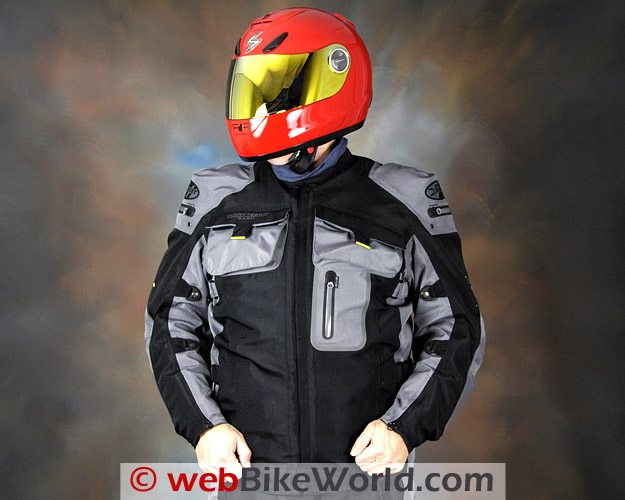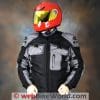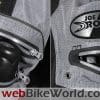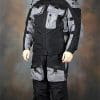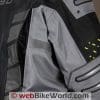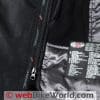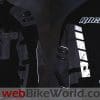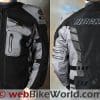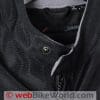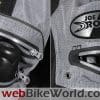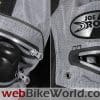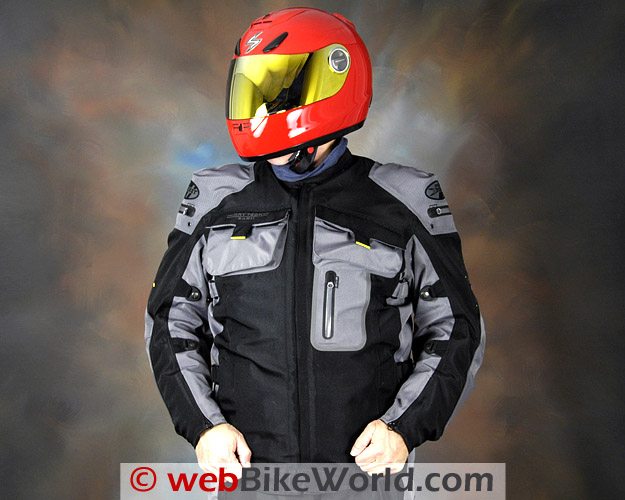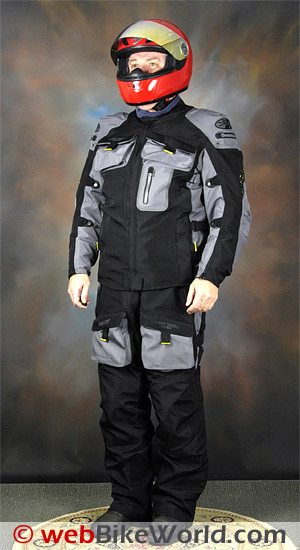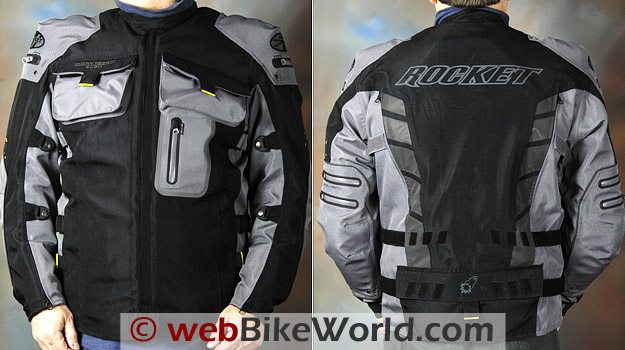A step up from previous Joe Rocket designs, the Dry Tech Nano jacket (and pants) are claimed “One Hundred Percent Waterproof”. The jacket has several unique features but the styling, the single color choice and a few details that seem a bit out of place on a $500.00 jacket may give pause to some potential owners. About 10 years ago, when we first started publishing product reviews, the Joe Rocket brand was known for inexpensive clothing that you’d buy only if you couldn’t afford anything else.
Those days are long gone, however, and the company is now known for building some very nice gear that is the first choice of many, at prices that are still affordable. They have slowly but surely evolved the product line, as evidenced by gear such as the Ballistic 3/4-length jacket, which is now at rev 8 with the new Ballistic 8.0.
The Ballistic jacket once held the top spot in the Joe Rocket textile jacket hierarchy, and it’s still a hugely popular choice and can be found at an excellent price compared to other brands. But it’s now 2010 and Joe Rocket has released the Dry Tech Nano jacket and pants as the new flagship outfit. Included are several unique features and, of course, the “Nano” fabric which, according to the company, was “originally developed as an air filtration system (that is so) effective that water is filtered from the air at the nano level”.
I’m not sure if my scientist friends would agree with that sentence, but the promise of “One Hundred Percent Waterproof” by Joe Rocket is the big draw here. I’ve been riding with the Nano outfit for the last few weeks, ducking snowflakes because it seems like months since we last liquid water coming from the sky instead of the white stuff. Thus, it is difficult to comment on the ability of the Nano jacket and pants to resist water, although we ran a couple of off-beat tests to try and get an idea.
What I can say is that the outfit is keeping me very warm and it compares with just about anything else I’ve worn in similar conditions and both the Nano jacket and Nano pants have outstanding wind-blocking capabilities.
But a couple of the features hold me back from giving a complete endorsement, including the styling and the availability of only the single black-and-gray color combination you see here. Also, the pants need a re-think in the way they’re cut, because the sizing is a bit odd. I’ll cover the pants in Part II of this review.
Meanwhile, let’s take a look at the Joe Rocket Dry Tech Nano Jacket. And by the way, I guess we can add this to our semi-continuing Fall Water-Resistant Jacket series, which I’ve re-labeled as the “2009-2010 Water-Resistant Clothing Series”, which includes the following:
The Joe Rocket Dry Tech Nano Jacket Shell
Perhaps there is a specific Joe Rocket strategy to let the clothing speak for itself. Or perhaps the marketing department is deliberately playing it low-key. I’ll believe the former.
But you’d think with brand-new and revolutionary (for Joe Rocket) jacket and pants “system” they’d be crowing about it every way they could. However, there just isn’t all that much technical information available regarding the Nano jacket and pants. The outfit just sort of showed up one day on the Joe Rocket website and that was that.
The most notable feature of the outfit is surely the namesake Nano fabric. What it is and how it works is somewhat of a mystery; apparently the fabric uses some type of nanotechnology treatment to repel water while allowing it to breathe.
The fabric used for the shell material is the now-typical Joe Rocket “Abrasion Resistant Rock Tex” of 600 Denier. The material is said to be “bonded to a nano web layer” that gives it water resistance (“waterproof” in Joe Rocket parlance) while also allowing it to breath, with “airflow permeability that rivals mesh jackets for maximum ventilation … even in a rain storm”.
I’m not sure about that, but I can say that the Nano jacket is amazingly windproof, noticeable immediately on my first ride wearing it, in 40-degree F temperatures. I’ve been wearing only a cotton T-shirt and cotton turtleneck underneath the jacket and I feel perfectly comfortable in the very cold weather, which is unusual.
The offset zipper on the liner, combined with a very large secondary storm flap under the main zipper, do an excellent job at preventing cold air from reaching the chest (notwithstanding the storm flap issues discussed in the next section).
In fact, if the jacket does hold up to anywhere near those breathability claims when the weather turns warm (one can only hope), then this jacket and this material truly will be revolutionary.
But back to the waterproof issue. Lots of claims have been made for “nano” products recently, and you’d probably need an atomic force microscope to determine the truth. Or a motorcyclist…
I’ll bet dollars to doughnuts somebody somewhere will be wearing the Nano outfit while riding in a downpour and will complain that it leaks. That’s why we use the term “water resistant” instead of “waterproof”.
I can’t really comment on the water resistance of the Nano outfit because of the record-breaking cold and snowy winter weather that established itself just about the time the Nano clothing arrived. We tried pouring water on it, soaking it, setting it in a bucket of ice water…and it seems like it meets Joe Rocket claims, but only time will tell.
Something else to note is the weight of the Nano jacket with its liner included. This jacket in size large weighs 2.7 kg (6 lbs.) and the pants in size XL weigh 2.3 kg (5 lbs.).
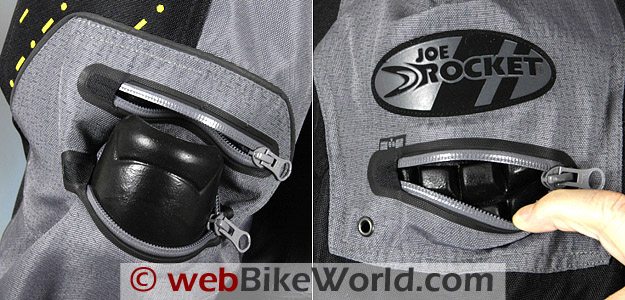
More Interesting Features of the Nano Jacket
Besides the Dry Tech Nano fabric, the jacket includes several other features of note:
Big Air Ventilation System: The main front zipper can be left open to expose a second zipper underneath that connects two sections of mesh fabric that run down the front of the jacket. Joe Rocket calls this their “Big Air Ventilation System”.
There’s a design issue here though. The jacket shell has a large permanently attached internal flap that acts as a wind blocker, and it works well. But it’s placed underneath the also permanently attached Big Air mesh panels that zip together.
So if the Big Air system is to be used in warm weather, the wind-blocking flaps underneath prevent the air from getting through, unless they are stuffed inside the jacket.
This can be done, and because the flaps are permanently attached, they can easily be folded back out and zippered up when the temperature drops. But I’m surprised there isn’t a method to attach the flaps inside the jacket when they’re not being used, perhaps with some hook-and-loop or snaps.
Rain Skirt:The jacket has a skirt around the bottom hem that secures with a couple of snaps on each side to the inside of the jacket shell when not in use and can be tightened around the rider’s waist when needed to keep out wind and water.
It has a large elastic band around the bottom and it’s a nice idea, found on other Joe Rocket jackets like the Ballistic 7.0 we reviewedand which was our 2007 Product of the Year.
This feature should be included in every jacket designed for cold or wet conditions, no matter the brand.
Pant and Waist Attachments: Under the skirt are four large belt loops which can be used to secure the jacket to a pants belt.
In addition, the jacket and the matching Joe Rocket Nano pants each have a small attachment zipper.
External Armor: Other features include shoulder armor that is placed on the outside of the shell, under a protective fabric.
The armor is removable from the outside of the jacket and although I’m not sure what that really does for you, having the armor on the outside seems to give a better fit to the jacket on the inside.
The elbow armor is also on the outside and it has two separate pockets that can be used to adjust the position for best fit.
Most of the external zippers are of the water-resistant type, but they probably don’t help the styling issues because of the 3 water-resistant zippers on either arm, which gives the jacket a busy look.
External Waist Adjusters: The sides of the jacket have dual waist adjusters, leaving a lot of hook-and-loop material to catch dirt and dander. We definitely noticed that the black material on the Nano jacket is like an incredibly strong magnet for picking up lint and pet hair; I’m not sure if this is related to the Nano fabric treatment or not, but it is very noticeable.
The jacket also includes a third hook-and-loop adjuster under the arms on each side, which helps pull the jacket snug around the chest, making for a tighter fit and less cold air movement underneath.
Color Choices: Which brings me to the single color choice. Perhaps the special treatment or fabric has something to do with the limited color, but it would be nice to have brighter colors in “Version 2.0”, or at least more of the yellow which is featured on the jacket in only very tiny dots on the sleeve and a hint of yellow on the pull tab ends.
A jacket made for riding in poor conditions like rain should be as visible as possible. So if you buy a Nano jacket, be sure to read our reviews of high-visibility and LED lighted vests — you may need one.
Joe Rocket Nano Jacket: Zippers, Vents
Since we’re in the middle of winter, I can’t comment on the warm-weather capabilities of the Nano jacket. As I mentioned above, the jacket and the warm and thick liner have kept me extraordinarily warm; thus, it’s difficult to believe that the jacket will have good ventilation in the summer.
But, anything’s possible — especially with the venting system on the Nano jacket, which includes the “Big Air” system up front and two large 26 cm long vertical zippers in the rear, just behind the arms.
Note that there are no other front vents on the chest or arms other than the Big Air system, which I have not tried due to the current weather conditions. How this system will work and whether or not I can get used to riding with the main front zipper open remains to be seen.
By the way, the front zippers are YKK labeled. The main shell zipper is black; the Big Air zipper is light gray and the liner zipper is black, but I had no problems confusing them.
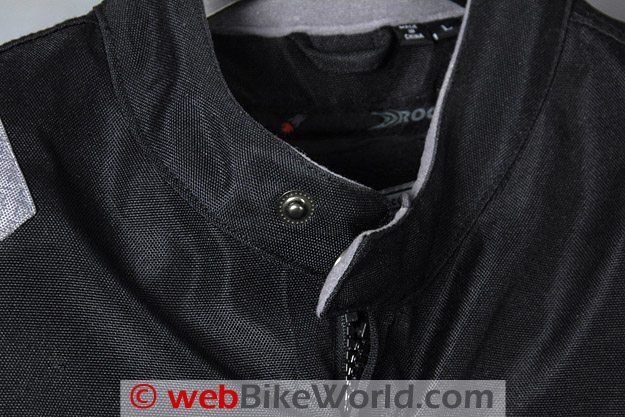
Jacket Collar: (Photo above). One thing that should be mentioned here is the collar. It has only a single snap, so the collar is non-adjustable, which I think is a big mistake and rather unforgiveable in a $500.00 jacket.
It uses a metal snap and otherwise the lining material used in the short collar is comfortable. I can just barely fit the collar around my 17″ neck when wearing a cotton turtleneck, so smaller or larger necks may have a problem and, in fact, this may be a deal-killer for some.
Liner and Sleeves: The sleeves of the jacket have a non-water-resistant zipper on the inside of the arm, covering a fabric dart to help prevent water ingress. The outer portion of the sleeve cuff has a small hook-and-loop tab that also covers a small dart. This leaves the sleeve cuffs relatively smooth and profiled, which help it fit into glove gauntlets.
However, for those who like to wear their gloves inside the sleeve, the liner is attached too far down the sleeve at the cuff and the hook-and-loop connectors prevent most larger gauntlets from fitting inside the sleeve. Also, the cuff zipper would have to be left all the way open, and the hook-and-loop tab on the outside of the cuff doesn’t really have enough adjustment to secure the jacket sleeve with a glove gauntlet underneath.
This is a problem that you might not discover until you owned the jacket, and it’s an oversight I think by Joe Rocket, especially on a jacket that is designed for wet-weather riding.
Joe Rocket Nano Jacket: Pockets
The hand warmer pockets feature a hook-and-loop flap covering a water-resistant zipper. These rubber-covered zippers can be difficult to operate, and opening the hand warmer pockets can be a two-handed job. I’d rather see a simple hook-and-loop flap or external zipper on these pockets because I use them more frequently than others, to store ear plugs, sunglasses, etc.
The Nano jacket has two cargo pockets on the upper chest, also covered with a hook/loop flap. The grab tabs for the pocket flap each have a “King Star” labeled metal spring snap to keep the flap secure.
These pockets feature a water-resistant zipper underneath and they’re lined with water-resistant material. A simple trial indicated they are indeed waterproof.
The left-hand cargo pocket features a little cell phone logo, while the pocket on the right has a dollar sign. It’s interesting to note that the right money pocket is noticeably larger than the cell phone pocket on the left, which is itself pretty big. Apparently Joe Rocket Nano jacket owners must carry a lot of cash! Of course, the pockets can be used for other items as well.
Just below the left-hand cargo pocket is a vertical patch pocket with a water-resistant zipper, which can hold an ID card, credit card, driver’s license, perhaps a small set of keys or similar.
On the left-hand side, inside the jacket in the mesh lining is a long narrow pocket that, it is said, can be used to stow a helmet face shield. There are no other pockets in the liner or the inside of the shell, which may disappoint some.
The jacket has a pocket at the lower rear and this pocket is narrower than most.
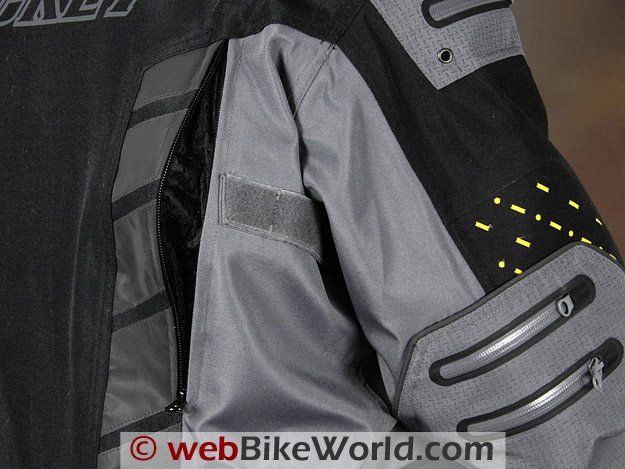
Armor and Padding
As mentioned above, the elbow armor is external, removable and adjustable in one of two positions. The standard position is fine for me and seems proportional to the jacket size. The shoulder armor is also external and removable, but not adjustable. It seems smaller than other shoulder armor, but I guess it will do the job. These armor bits are CE-approved, according to Joe Rocket.
The Nano jacket also includes a removable back pad, which actually feels more substantial and larger than most of the flimsy foam padding used in many jackets. Joe Rocket sells an optional back protector that will fit.
Joe Rocket Nano Jacket Sizing and Fit
The Nano jacket shown here is a size large, chosen from the Joe Rocket size chart, which shows a size large fitting a 42-44″ chest and 34-36″ waist. I’m at the upper end of that range and the jacket fits me just as I like it.
Someone at the lower end of the range may find the initial fit slightly loose, but the wide range of adjustment offered with the sleeve adjusters, two waist adjusters and the chest (side) adjusters on either side should help the jacket fit perfectly.
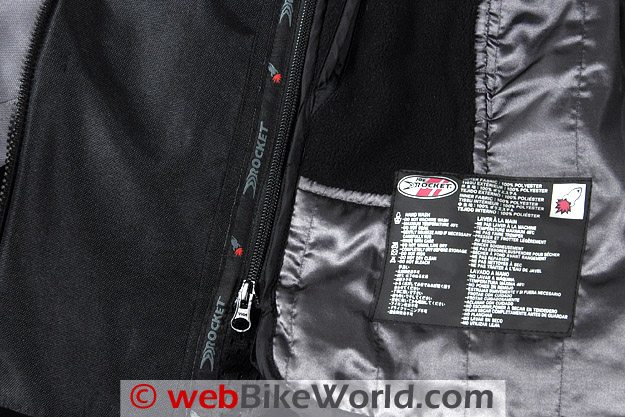
Nano Jacket Insulating Liner
The Nano jacket liner is different than other Joe Rocket insulating liners; it has a combination fleece and rayon taffeta-type material.
The material used in liner is actually much thinner than one might expect, especially considering the warmth it provides, so they did something special here that definitely works, along with the wind-resistant shell. However, the six-pound weight of the jacket is even more mysterious if the liner isn’t to blame.
A single one-way zipper is used to attach the insulating liner to the jacket.
It is sewn all the way around the plackets and the neck and back down the other side, which prevents access to the inside of the shell even if there were pockets to access there.
The liner sleeve cuffs attach with hook-and-loop inside the jacket sleeves, and this, combined with the single zipper, makes it easy to remove the liner.
But note the glove gauntlet issues as noted above for motorcyclists who like to wear their gloves underneath the sleeve, as is often the case when riding in the rain.
Wearing the Joe Rocket Dry Tech Nano Jacket
It takes a bit more effort to get into the Nano jacket, due to the offset wind-blocking internal flap and the three sets of zippers when the liner is installed.
The single collar snap takes two hands to close, at least on my neck, which seems to be at the limit of the diameter for the non-adjustable collar.
But once the jacket is on, it’s very comfortable and I think having the elbow and shoulder armor on the outside makes a positive difference in comfort on the inside.
The liner material is also very soft, although it picks up lint and pet hair even quicker than the magnet-like shell.
Overall, the jacket is very comfortable and the tailoring is form-fitting, which should offer good protection to the wearer from wind, rain and asphalt.
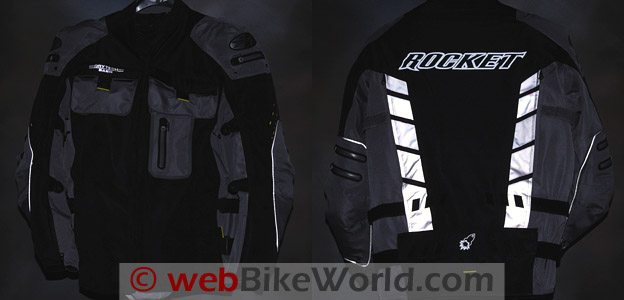
Reflectivity
The Nano jacket has a couple of strips of highly reflective material on the back, that is unfortunately dark gray during the daylight. The “Rocket” logo is also reflective, as can be seen in the photo above.
The front of the jacket has very little reflective material other than some piping on the sleeves and the small logo on the right pocket.
The Rest of the Story
Stitching: Most of the seams are double-stitched and external, which looks less streamlined than some of the single-stitched blind seams used in other high-end jackets. The material used for the stitching is unknown.
Styling: The overall design of the jacket is rather busy, especially with the three external hook-and-loop adjusters on either side and the three waterproof armor zippers on each sleeve. So I can’t say the Nano jacket has a streamlined appearance, but that’s a matter of personal taste.
Sleeve Adjusters: The Nano jacket has dual sleeve adjusters on each arm, both with three adjustment points (metal snaps) and elastic stretch material on the snap.
Comparison: Overall, the Joe Rocket Nano jacket provides outstanding wind protection and warmth and, hopefully, rain protection as well.
|
webBikeWorld Opinionator – Joe Rocket Dry Tech Nano Jacket
|
|
|---|---|
|
Picks…
|
…and Pans
|
|
|
Conclusion
The Joe Rocket Dry Tech Nano jacket leaves me with mixed feelings. On one hand, I can definitely appreciate the warmth and wind protection the jacket provides in our current winter weather conditions.
But I wish it had a bit more demure styling and was available in brighter color combinations. Lighter weight wouldn’t hurt either.
I get a feeling that Joe Rocket wanted to develop something to compete in the high-end jacket market and ended up throwing every design trick they could think of at the Nano jacket to try and make a splash. But motorcyclists who are willing to spend this much money on a high-end jacket are more conservative, valuing function over styling.
Also, these customers are usually very skilled and experienced motorcyclists who know exactly what they want in a jacket and how it should work. I’m not sure how they — you — will react to the Joe Rocket Nano jacket, but the good news is that this is a company that doesn’t rest on its laurels, and I’ll again bet those dollars to those doughnuts that “Version 2.0” of the Nano jacket will be much improved.
Part II: Joe Rocket Dry Tech Nano Pants Review
|
wBW Review: Joe Rocket Dry Tech Nano Jacket
|
|
|---|---|
| Manufacturer: Joe Rocket | List Price: $499.00 – $514.99 |
| Colors: Black/gray only. | Made In: China |
| Sizes: S to 3XL. | Star Rating (1-5): |
| Review Date: February 2010
Note: Item was provided by a retailer, distributor or manufacturer with these Terms and Conditions.
|
|
Owner Comments and Feedback
See details on submitting comments.
From “J.C.” (November 2011): “I have been reading your reviews on helmets and clothing, as I’m in the market for some new gear. With regards to your Joe Rocket Dry Tech Nano jacket, I believe that its waterproofing is from a process where fibers are created to project out from the surface of the fabric like tiny hairs. It is these “hairs” which prevent the water molecule from touching the surface of the fabric.
This does result in a totally waterproof material. The principal was found from studying lotus leaves, if I recall correctly. Anyways, thank you for the reviews.”
From “R.E.” (2/10): “During a recent summer trip to New Zealand, I had a chance to try out the Nano jacket and can say it kept me cool into the mid 80’s utilizing the big air and open the back with nothing else on except a t-shirt.
For me, the weight wasn’t a factor and overall, with the number of available adjustments, the jacket proved to be very comfortable.
I could do without the large “Rocket” on the back and agree it would be nice to have more visibility from the front. I cannot comment on the “waterproof” claims, but did keep me dry with the little moisture I have experienced with it.”
From “P.P.” (2/10): “It’s always good to see some new technology in riding gear, but I wonder if it is really better than good old Gore-Tex, or just different.
I’m never all that into a product’s styling, but the Rocket Dry Tech Nano is over the top. Maybe the asymmetric design matches the BMW GS and 1300SS? And for the price of the jacket alone, about what I paid for my Olympic AST and pants, and more than an Aerostich Roadcrafter jacket, it’s out of my league. Maybe on-line retailers will discount it into a more realistic price. Where’s the hi-viz yellow?”


